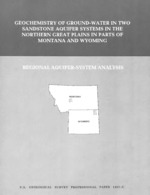Geochemistry of ground-water in two sandstone aquifer systems in the Northern Great Plains in parts of Montana and Wyoming, North Dakota, and South Dakota
Links
- Document: Report (pdf)
- Download citation as: RIS | Dublin Core
Abstract
The Kootenai Formation in the Judith Basin, Montana, and the Lance Formation and Fox Hills Sandstone in the Powder River Basin, Wyoming, constitute two important sandstone aquifer systems in the Northern Great Plains region. Ground waters in each of these systems evolve from low dissolved-solids concentration, near-neutral pH, predominantly calcium and magnesium bicarbonate types in their recharge areas, to high dissolved-solids concentration, high pH, predominantly sodium-bicarbonate types in the basins. Oxidation potentials decrease as the waters flow downgradient under confined conditions. Calculation of the saturation states of aquifer minerals suggests several groups of mineral phases that could control ground-water chemistry. Mass transfer modeling indicates, however, that the observed behavior of major and minor dissolved species in both systems can satisfactorily be explained only by equilibration with calcite, dolomite, or calcite and dolomite. The geochemistry of these systems is probably controlled by the incongruent dissolution of dolomite to form calcite. This reaction appears to be driven by cation exchange and the dissolution of carbon dioxide. Plausible carbon dioxide sources include organic carbon oxidation and lignite coalification. Aluminosilicates influence major element chemistry primarily as subtrates for cation exchange, which, in combination with carbonate equilibria, buffer ground water pH at values of 8.5 to 8.9. Dissolved-iron concentrations are controlled by equilibration with amorphous ferric oxyhydroxides in oxidizing waters, with amorphous ferric oxyhydroxides and siderite in moderately reducing waters, and with siderite and amorphous ferrous sulfide in strongly reducing waters. Measured variations in dissolved carbonate isotopic composition compare favorably with carbon isotopic evolution, calculated by assuming dedolomitization.
Recharge areas of the two systems are characterized by ground waters with high tritium and carbon-14 activities and relatively low dissolved-solids concentrations, with calcium and magnesium as the predominant cations. Recharge temperatures, calculated from dissolved-argon concentrations and 5180 and SD isotopic measurements, indicate that recharge is derived primarily from spring snow-melt rather than late spring and summer storms. Ground-water flow directions are generally parallel to trends of increasing dissolved solids concentrations and decreasing divalent to monovalent cation concentration ratios. However, these trends are sometimes obscured in areas of leakage or mixing. Further indication of leakage between aquifers is provided by abrupt changes in major element and isotopic chemistry, which are not characteristic of normally observed geochemical evolution. Ground-water flow rates, calculated by adjusting measured carbon-14 activities for carbonate mass transfer, are comparable to values calculated from aquifer tests and potentiometric data. These carbon-14 flow rates average 1.6 meters per year for the Second Cat Creek sandstone of the Kootenai Formation, and 1.3 meters per year for the Lance-Fox Hills aquifer.
Study Area
| Publication type | Report |
|---|---|
| Publication Subtype | USGS Numbered Series |
| Title | Geochemistry of ground-water in two sandstone aquifer systems in the Northern Great Plains in parts of Montana and Wyoming, North Dakota, and South Dakota |
| Series title | Professional Paper |
| Series number | 1402 |
| Chapter | C |
| DOI | 10.3133/pp1402C |
| Year Published | 1985 |
| Language | English |
| Publisher | U.S. Geological Survey |
| Publisher location | Reston, VA |
| Description | viii, 84 p. |
| Country | United States |
| State | Montana, North Dakota, South Dakota, Wyoming |
| Other Geospatial | Northern Great Plains |


